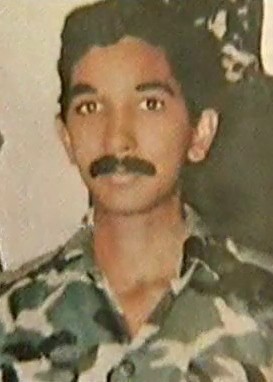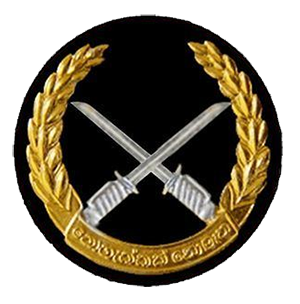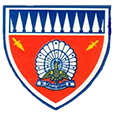
Captain Samarakoon Wasala Mudiyanselage Saliya Upul Aladeniya, PWV, SLRS was a Sri Lankan soldier and the second recipient of the Parama Weera Vibhushanaya, Sri Lanka's highest wartime award for valor. He was commanding the small army detachment at Kokavil; when it was surrounded he refused to abandon the injured and fought until they were overrun by the Liberation Tigers of Tamil Eelam (LTTE).

The Commando Regiment is the commando formation of the Sri Lanka Army. The unit specializes in various roles including hostage rescue, counter-terrorism, unconventional warfare, special reconnaissance, counter-insurgency, and personnel recovery. It was formed in 1980 and is based in Ganemulla, a suburb of Colombo.

Eelam War II is the name given to the second phase of armed conflict between Sri Lankan military and the separatist Liberation Tigers of Tamil Eelam. The war started after the failure of peace talks between the Premadasa government and the LTTE. This phase of the war was initiated by the LTTE who massacred almost 600 Sinhalese and Muslim police personnel after they were ordered by the Premadasa government to surrender to the LTTE. The truce was broken on June 10, 1990 when the LTTE in October expelled all the 28,000 Muslims residing in Jaffna.

The Sri Lanka Sinha Regiment (SLSR) is an infantry regiment of the Sri Lanka Army; it is the second oldest infantry regiment in the army.

The Gemunu Watch (GW) ("King Dutugemunu's Own") is a infantry regiment of the Sri Lanka Army, formed with troops from the Ceylon Light Infantry and the Ceylon Sinha Regiment in 1962. It has been deployed in many major operations against the LTTE. It is made up of 14 regular units and 9 volunteer units. Headquartered at Kuruwita Army Camp, Ratnapura. It is named after one of the most famous Lankan Kings, King Dutugemunu.
The Battle of Mullaitivu, also known as the First Battle of Mullaitivu and codenamed Operation Unceasing Waves-1, was a battle between the militant Liberation Tigers of Tamil Eelam and the Sri Lankan military during the Sri Lankan Civil War for control of the military base in Mullaitivu in north-eastern Sri Lanka.

The First Battle of Elephant Pass was a battle fought in July 1991 for the control of the Sri Lankan military base of Elephant Pass, which was of strategic importance as it linked the northern mainland known as Wanni with the Jaffna Peninsula. The battle was fought between troops of the Sri Lankan army and the Liberation Tigers of Tamil Eelam, commonly known as LTTE.
The Battle of Pooneryn, was a battle between the militant Liberation Tigers of Tamil Eelam and the Sri Lankan military during the Sri Lankan Civil War for control of the military base in Pooneryn in northern Sri Lanka from 11 November to 14 November 1993.
The Battle of Kilinochchi was a battle that occurred in September 1998 for the control of the city of Kilinochchi in Sri Lanka. The battle was fought between the Sri Lankan Army (SLA) and the Liberation Tigers of Tamil Eelam (LTTE).
The Northern Theater of Eelam War IV refers to the fighting that took place in the northern province of Sri Lanka between July 2006 and May 18, 2009.
Operation Balavegaya was a combined military operation launched by the Sri Lankan military in Jaffna, the largest amphibious assault in its history. Operation Balavegaya was launched in response to the siege of Elephant Pass by the LTTE. It is believed that Operation Balavegaya was the largest and most successful military operation of the Sri Lankan military until Operation Riviresa in 1995.
The 2008–2009 SLA Northern offensive was an armed conflict in the northern Province of Sri Lanka between the military of Sri Lanka and the separatist Liberation Tigers of Tamil Eelam (LTTE). The battle broke with the Sri Lanka Army (SLA) offensive attempting to break through the LTTE defence lines in the north of the island, aiming to conclude the country's 25-year-old civil war by military victory.
Operation Jayasikurui, was a Sri Lankan military operation launched on 13 May 1997, it lasted until 1999, when it was called off. The operation was initially launched for 6 months but cancelled after 18 months as Sri Lankan government faced huge loss. It was the largest military operation undertaken by the armed forces at the time.

Velayuthapillai Baheerathakumar was a leading member of the Liberation Tigers of Tamil Eelam (LTTE), a separatist Tamil militant organisation in Sri Lanka. He played a leading role in the LTTE's military victories in the Vanni during Eelam War III, including Mullaitivu (1996), Kilinochchi (1998), Oddusuddan (1999) and Elephant Pass (2000). He was killed at the Battle of Ananthapuram in the last days of the Sri Lankan Civil War.
Kokavil is a village in Mullaitivu District, Sri Lanka, also called Kokkavil. It is situated along the A-9 road.

The Battle of Kilinochchi was a land battle fought between the Sri Lankan Military and the Liberation Tigers of Tamil Eelam (LTTE) for control of the town of Kilinochchi in the Northern Theater of Eelam War IV during the Sri Lankan civil war between November 2008 and January 2009. The town of Kilinochchi was the administrative center and de facto capital of the LTTE's proposed state of Tamil Eelam.
The Battle of Vavunathivu took place during the Sri Lankan Civil War. It occurred on 7 March 1997 in which the LTTE militants attacked and overran the Sri Lanka Army military camp at Vavunathivu off Batticaloa.
A mass murder of Sri Lankan Police officers took place on 11 June 1990. Members of the Liberation Tigers of Tamil Eelam (LTTE), a militant organization, are alleged to have killed over 600 unarmed Sri Lanka Police officers in Eastern Province, Sri Lanka. Some accounts have estimated the number killed as high as 774.
The Battle of Kanakarayankulam was fought on 4 December 1997, during the Sri Lankan civil war between the Sri Lanka Armed Forces and the Liberation Tigers of Tamil Eelam (LTTE). It is known as the "worst-ever commando debacle" in Sri Lankan military history.
The Battle of Mandaitivu took place during the Sri Lankan Civil War. It occurred on 28 June 1995 in which the LTTE militants attacked and overran the Sri Lanka Army detachment in the island of Mandaitivu in Jaffna.







